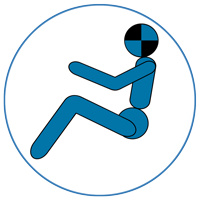This title includes the technical papers developed for the 2022 Stapp Car Crash Conference, the premier forum for the presentation of research in impact biomechanics, human injury tolerance, and related fields, advancing the knowledge of land-vehicle crash injury protection.
Topics covered in this issue include:
- Automobile accidents, crash scenarios, injury biomechanics, occupant kinematics
- Finite element models, simulations, human body models
- Head injury metrics, injury biomechanics
Purchase Vol. 66 through SAE (Print | Digital)
-
Investigation of Potential Injury Patterns and Occupant Kinematics in Frontal Impact with PMHS in Reclined Postures Pascal Baudrit and Jérôme Uriot — CEESAR (Nanterre – France) Olivier Richard and Matthieu Debray — Faurecia Automotive Seating (France) Abstract The reality of the autonomous vehicle in a near future is growing and is expected to induce significant change in the occupant posture with respect to a standard driving posture. The delegated driving would allow sleeping and/or resting in a seat with a reclined posture. However, the data in…
-
Obese Occupant Response in Reclined and Upright Seated Postures in Frontal Impacts Karthik Somasundaram, John R. Humm, Narayan Yoganandan, Hans Hauschild, Klaus Driesslein, and Frank A. Pintar — Medical College of Wisconsin and VA Medical Center Abstract The American population is getting heavier and automated vehicles will accommodate unconventional postures. While studies replicating mid-size and upright fore-aft seated occupants are numerous, experiments with post-mortem human subjects (PMHS) with obese and reclined occupants are sparse. The objective of this study was to compare…
-
Driving Behavior during Right-Turn Maneuvers at Intersections on Left-Hand Traffic Roads Yasuhiro Matsui and Naruyuki Hosokawa — National Traffic Safety and Environment Laboratory, Japan Shoko Oikawa — Tokyo Metropolitan University, Japan Abstract In Japan, where vehicles drive on the left side of the road, pedestrian fatal accidents caused by vehicles traveling at speeds of less than or equal to 20 km/h, occur most frequently when a vehicle is turning right. The objective of the present study is to clarify the driving…
-
Effect of Tissue Erosion Modeling Techniques on Pedestrian Impact Kinematics Daniel Grindle and Costin Untaroiu — Department of Biomedical Engineering and Mechanics (BEAM), C Abstract The pedestrian is one of the most vulnerable road users and has experienced increased numbers of injuries and deaths caused by car-to-pedestrian collisions over the last decade. To curb this trend, finite element models of pedestrians have been developed to investigate pedestrian protection in vehicle impact simulations. While useful, modeling practices vary across research groups,…
-
Understanding Head Injury Risks during Car-to-Pedestrian Collisions Using Realistic Vehicle and Detailed Human Body Models Kalish Gunasekaran, Sakib Ul Islam, and Haojie Mao — Mechanical and Materials Engineering, Western University, Lo Abstract Traumatic brain injury (TBI) is the leading cause of death and long-term disability in road traffic accidents (RTAs). Researchers have examined the effect of vehicle front shape and pedestrian body size on the risk of pedestrian head injury. On the other hand, the relationship between vehicle front shape parameters and pedestrian TBI risks…
-
A Comparison of the Mid-Size Male THOR and Hybrid III ATDs in Vehicle Frontal Crash Tests Chris O’Connor, Agnes Kim and Tim Barrette — Ford Motor Company Jeff Dix — Nissan North America Abstract In order to evaluate the THOR-50M as a front impact Anthropomorphic Test Device (ATD) for vehicle safety design, the ATD was compared to the H3-50M in matching vehicle crash tests for 20 unique vehicle models from 2 vehicle manufacturers. For the belted driver condition, a total of fifty-four crash tests were investigated in the…
-
Lower Extremity Validation of a Human Body Model for High Rate Axial Loading in the Underbody Blast Environment Zachary S. Hostetler, Juliette Caffrey, Jazmine Aira, and F. Scott Gayzik — Wake Forest School of Medicine- Biomedical Engineering Abstract While the use of Human Body Models (HBMs) in the underbody blast (UBB) environment has increased and shown positive results, the potential of these models has not been fully explored. Obtaining accurate kinematic and kinetic response are necessary to better understand the injury mechanisms for military safety applications. The objective…
-
Ligaments Laxity and Elongation at Injury in Flexed knees during Lateral Impact Conditions Sahar Benadi — LAB PSA Renault (Nanterre – France), Univ Lyon, Univ Gustave Eiffel, Univ Claude Bernard Lyon 1 Xavier Trosseille and Philippe Petit — LAB PSA Renault (Nanterre – France) Jérôme Uriot — CEESAR (Nanterre – France) Yoann Lafon and Philippe Beillas — Univ Lyon, Univ Gustave Eiffel, Univ Claude Bernard Lyon 1 Abstract The knee is one of the regions of interest for pedestrian safety assessment. Past testing…
Publisher: SAE International and The Stapp Association
Specs: Published by SAE International and the Stapp Association with a Product Code of STAPP2022-EJ, ISSN of 2993-1940
